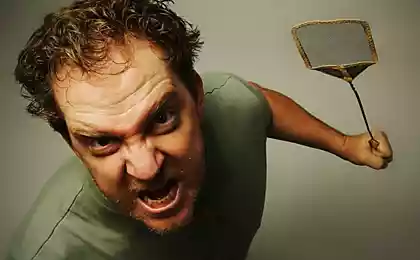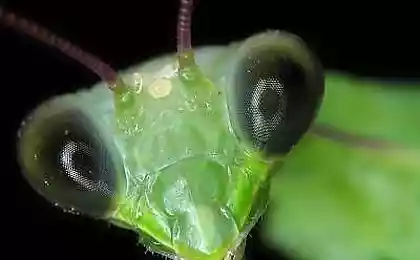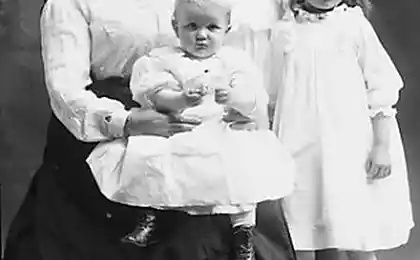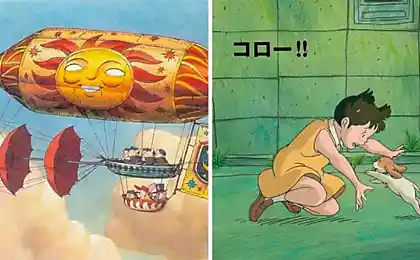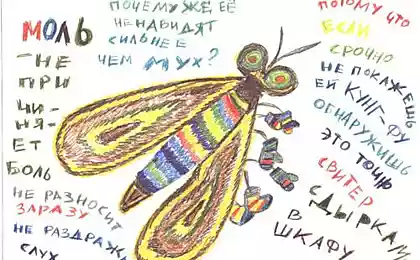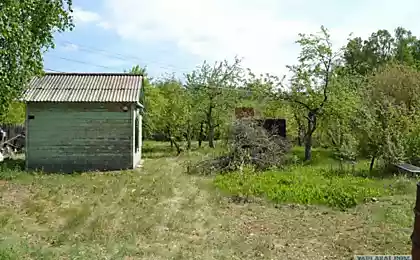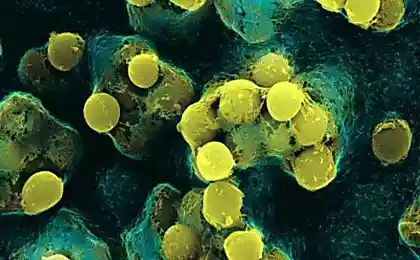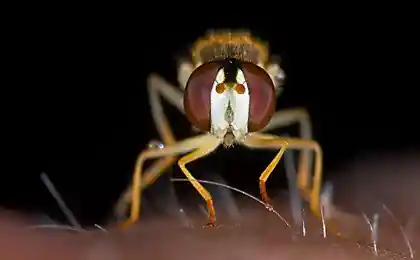599
Brutal gnats, Part 2
Superchervyak
The larvae of the so-called hair-(Spinochordodes Tellinii) develop and grow within the Orthoptera insects such as grasshoppers and crickets. In the process of growing larvae eat their host from the inside, leaving intact only the head, limbs and chitin skeleton. Once the parasite grows to the size of the adult (and it is 3 times longer than a grasshopper), he takes control in their legs (although paws had not), and directs the grasshopper / cricket towards the large pond nearby, forcing the poor guy to jump into the water. There are hair-worm crawls out of the host, which then sinks, and not realizing what happened to him ...

Costa Rican wasp
After these articles I will be wary of wasps - many of them are terrible by our standards villains destroying other insects. For example, the wasp, which is found in Costa Rica (Hymenoepimecis argyraphaga), which for their offspring using spiders Plesiometa argyra. When the wasp it is time to lay eggs with offspring, she finds a spider paralyzes him and lays her eggs directly into the belly of an insect. Larvae developing, through the tiny holes in the eggs feed on the blood of a spider, while the spider, suspecting nothing, and continues to spin a web to catch insects for two weeks. Once the wasps' offspring within the spider is ready for independent living, the larvae secrete into the bloodstream spider specific substances could cause the spider weaves quite unusual for a network, and is fixed in its center. "Gratitude" osyata then kill poison spider inside, eat it, and in the center he created the web creates a cocoon, which grow to the size of adult wasps of the species. After this cycle is ready to proceed.
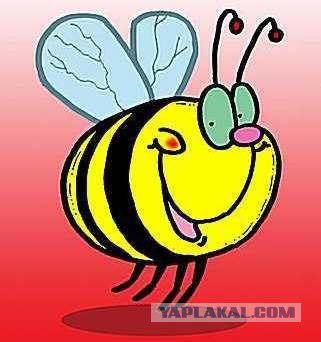
Fierce mold
Besides insects, it is also engaged in pranks grown-type fungus Cordyceps Unilateralis, which infects ants and change their behavior in order to expand their habitat. The spores enter the body through a special breathing ant holes, through which breathes the ant. There's a fungus begins to dissolve the non-critical soft tissue. Once the spores develop enough, they penetrate into the brain of an ant, causing the ant to climb to the highest grass and tightly secured there mandibles (jaws). After that, the ant dies, and the fungus grows right out of his head, throwing their disputes around.

Wasp and caterpillar
Again wasp! In Central and North America are found wasp species Glyptapanteles, which parasitize caterpillars accidents. When the female wasp offspring is going to delay, she finds a caterpillar, as usual paralyzing her and puts into up to 80 eggs. The children in the development process of host all drink the sap until it grow - caterpillar big, and they have enough. After that, almost all osyata selected from caterpillars and form a cocoon around her, which continues to grow. However, two or three larvae remain inside working "guards." Once the pod is in danger, "guards" manipulate the nervous system tracks so that it begins to squirm, acting like a big club and sweeping all around without touching the cocoon. Once all the larvae are fully developed in the OS, and leave the caterpillar, killing her in passing. Miracles and only ...
Source

Source:
The larvae of the so-called hair-(Spinochordodes Tellinii) develop and grow within the Orthoptera insects such as grasshoppers and crickets. In the process of growing larvae eat their host from the inside, leaving intact only the head, limbs and chitin skeleton. Once the parasite grows to the size of the adult (and it is 3 times longer than a grasshopper), he takes control in their legs (although paws had not), and directs the grasshopper / cricket towards the large pond nearby, forcing the poor guy to jump into the water. There are hair-worm crawls out of the host, which then sinks, and not realizing what happened to him ...

Costa Rican wasp
After these articles I will be wary of wasps - many of them are terrible by our standards villains destroying other insects. For example, the wasp, which is found in Costa Rica (Hymenoepimecis argyraphaga), which for their offspring using spiders Plesiometa argyra. When the wasp it is time to lay eggs with offspring, she finds a spider paralyzes him and lays her eggs directly into the belly of an insect. Larvae developing, through the tiny holes in the eggs feed on the blood of a spider, while the spider, suspecting nothing, and continues to spin a web to catch insects for two weeks. Once the wasps' offspring within the spider is ready for independent living, the larvae secrete into the bloodstream spider specific substances could cause the spider weaves quite unusual for a network, and is fixed in its center. "Gratitude" osyata then kill poison spider inside, eat it, and in the center he created the web creates a cocoon, which grow to the size of adult wasps of the species. After this cycle is ready to proceed.

Fierce mold
Besides insects, it is also engaged in pranks grown-type fungus Cordyceps Unilateralis, which infects ants and change their behavior in order to expand their habitat. The spores enter the body through a special breathing ant holes, through which breathes the ant. There's a fungus begins to dissolve the non-critical soft tissue. Once the spores develop enough, they penetrate into the brain of an ant, causing the ant to climb to the highest grass and tightly secured there mandibles (jaws). After that, the ant dies, and the fungus grows right out of his head, throwing their disputes around.

Wasp and caterpillar
Again wasp! In Central and North America are found wasp species Glyptapanteles, which parasitize caterpillars accidents. When the female wasp offspring is going to delay, she finds a caterpillar, as usual paralyzing her and puts into up to 80 eggs. The children in the development process of host all drink the sap until it grow - caterpillar big, and they have enough. After that, almost all osyata selected from caterpillars and form a cocoon around her, which continues to grow. However, two or three larvae remain inside working "guards." Once the pod is in danger, "guards" manipulate the nervous system tracks so that it begins to squirm, acting like a big club and sweeping all around without touching the cocoon. Once all the larvae are fully developed in the OS, and leave the caterpillar, killing her in passing. Miracles and only ...
Source

Source:

